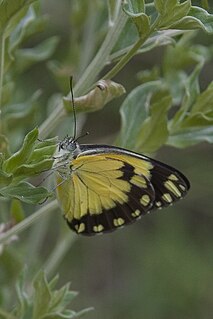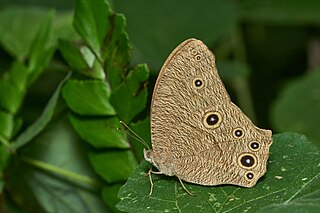 W
WLepidoptera of Cape Verde represent about 280 known species. A total of 252 moth species have been recorded. Twenty-eight species of butterflies are known from Cape Verde, none of which are endemic. The moths and butterflies together make up the taxonomic order Lepidoptera.
 W
WAzanus jesous, the African babul blue or topaz-spotted blue, is a small butterfly found in Africa, Egypt, Syria, India, Sri Lanka and Myanmar that belongs to the lycaenids or blues family.
 W
WAzanus mirza, the pale babul blue or mirza blue, is a butterfly of the family Lycaenidae. It is found in the Afrotropical realm.
 W
WAzanus moriqua, the black-bordered babul blue or thorn-tree blue, is a butterfly of the family Lycaenidae. It is found in the Afrotropical realm.
 W
WBelenois creona, the African common white or African caper, is a butterfly in the family Pieridae. It is found in the Afrotropical realm.
 W
WByblia ilithyia, the spotted joker or joker, is a species of nymphalid butterfly found in parts of Africa and Asia.
 W
WCatopsilia florella, the African migrant, African emigrant, or common vagrant, is a butterfly of the family Pieridae. It is found in Africa and the Canary Islands. Like Catopsilia pomona, this species also has a habit of migration.
 W
WCoeliades forestan, the striped policeman, is a butterfly of the family Hesperiidae. It is found from Transkei to Zimbabwe and to Botswana. It is also present on Madagascar and Mauritius.
 W
WColias croceus, clouded yellow, is a small butterfly of the family Pieridae, that is, the yellows and whites.
 W
WColotis euippe is a butterfly of the family Pieridae that is found in the Afrotropical realm.
 W
WEurema hecabe, the common grass yellow, is a small pierid butterfly species found in Asia, Africa and Australia. They are found flying close to the ground and are found in open grass and scrub habitats. It is simply known as "the grass yellow" in parts of its range; the general term otherwise refers to the entire genus Eurema.
 W
WHypolimnas misippus, the Danaid eggfly, mimic, or diadem, is a widespread species of nymphalid butterfly. It is well known for polymorphism and mimicry. Males are blackish with distinctive white spots that are fringed in blue. Females are in multiple forms that include male-like forms while others closely resemble the toxic butterflies Danaus chrysippus and Danaus plexippus. They are found across Africa, Asia, and Australia. In the new world they are found in the West Indies, with strays in Central and North America.
 W
WThe large tortoiseshell or blackleg tortoiseshell is a butterfly of the family Nymphalidae.
 W
WLeptotes pirithous, the Lang's short-tailed blue or common zebra blue, is a butterfly of the family Lycaenidae.
 W
WMelanitis leda, the common evening brown, is a common species of butterfly found flying at dusk. The flight of this species is erratic. They are found in Africa, South Asia and South-east Asia extending to parts of Australia.
 W
WPapilio demodocus, the citrus swallowtail or Christmas butterfly, is a swallowtail butterfly which commonly occurs over the entirety of sub-Saharan Africa, including Madagascar, besides the southern Arabian Peninsula. The caterpillars feed on various native plants of especially the family Rutaceae, but have also taken to the leaves of cultivated citrus trees.
 W
WPontia daplidice, the Bath white, is a small butterfly of the family Pieridae, the yellows and whites, which occurs in the Palearctic region. It is common in central and southern Europe, migrating northwards every summer, often reaching southern Scandinavia and sometimes southern England.
 W
WPontia glauconome, the desert white or desert Bath white, is a butterfly in the family Pieridae. It is found in Mauritania, Senegal, Gambia, Niger, Chad, Sudan, Ethiopia, Somalia, Kenya, Arabia, Egypt, the Middle East, Pakistan, Afghanistan, the southern part of the former Soviet Union, Uzbekistan, Tajikistan and Turkmenistan. The habitat consists of sub-deserts.
 W
WVanessa cardui is a well-known colourful butterfly, known as the painted lady, or formerly in North America as the cosmopolitan.